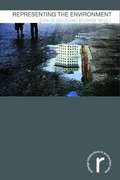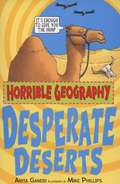- Table View
- List View
Encyclopedia of Environmental Change: Three Volume Set
by John A MatthewsAccessibly written by a team of international authors, the Encyclopedia of Environmental Change provides a gateway to the complex facts, concepts, techniques, methodology and philosophy of environmental change. This three-volume set illustrates and examines topics within this dynamic and rapidly changing interdisciplinary field. The encyclopedia includes all of the following aspects of environmental change: Diverse evidence of environmental change, including climate change and changes on land and in the oceans Underlying natural and anthropogenic causes and mechanisms Wide-ranging local, regional and global impacts from the polar regions to the tropics Responses of geo-ecosystems and human-environmental systems in the face of past, present and future environmental change Approaches, methodologies and techniques used for reconstructing, dating, monitoring, modelling, projecting and predicting change Social, economic and political dimensions of environmental issues, environmental conservation and management and environmental policy Over 4,000 entries explore the following key themes and more: Conservation Demographic change Environmental management Environmental policy Environmental security Food security Glaciation Green Revolution Human impact on environment Industrialization Landuse change Military impacts on environment Mining and mining impacts Nuclear energy Pollution Renewable resources Solar energy Sustainability Tourism Trade Water resources Water security Wildlife conservation The comprehensive coverage of terminology includes layers of entries ranging from one-line definitions to short essays, making this an invaluable companion for any student of physical geography, environmental geography or environmental sciences.
Snow In The Kitchen (PDF)
by Richard BrownA series of ELT readers for young learners of English. I was ill and I couldn't go out in the snow, but Mum had a wonderful idea.
Bug Club Green A Dixie's Pocket Zoo: Brave The Waves (PDF)
by Pip JonesWhen Dixie spots a sinking boat, she turns to her magic pocket zoo for help. Can the animals save the day and bring everyone to safety?
The Atlantic
by Paul ButelFrom Antiquity to modern times, the Atlantic has been the subject of myths and legends. The Atlantic by Paul Butel offers a global history of the ocean encompassing the exploits of adventurers, Vikings, explorers such as Christopher Columbus, emigrants, fishermen, and modern traders. The book also highlights the importance of the growth of ports such as New York and Liverpool and the battles of the Atlantic in the world wars of the twentieth century. The author offers an examination of the legends of the ocean, beginning with the Phoenicians and Carthaginians navigating beyong the Pillars of Hercules, and details the exploitation and power struggles of the Atlantic through the centuries. The book surveys the important events in the Atlantic's rich history and comprehensively analyses the changing fortunes of sea-going nations, including Britain, the United States and Germany.
The Atlantic (PDF)
by Paul ButelFrom Antiquity to modern times, the Atlantic has been the subject of myths and legends. The Atlantic by Paul Butel offers a global history of the ocean encompassing the exploits of adventurers, Vikings, explorers such as Christopher Columbus, emigrants, fishermen, and modern traders. The book also highlights the importance of the growth of ports such as New York and Liverpool and the battles of the Atlantic in the world wars of the twentieth century. The author offers an examination of the legends of the ocean, beginning with the Phoenicians and Carthaginians navigating beyong the Pillars of Hercules, and details the exploitation and power struggles of the Atlantic through the centuries. The book surveys the important events in the Atlantic's rich history and comprehensively analyses the changing fortunes of sea-going nations, including Britain, the United States and Germany.
Representing The Environment
by John Gold George RevillThe development of the environmental movement has relied heavily upon written and visual imagery. Representing the Environmentoffers an introductory guide to representations of the environment found in the media, literature, art and everyday life encounters. Featuring case studies from Europe, the Americas and Australia, Representing the Environmentprovides practical guidance on how to study environmental representations from a cultural and historic perspective, and places the reader in the role of active interpreter. The book argues that studying representations provides an important lens on the development of environmental attitudes, values and decision-making.
Collective Action
by Russell HardinPublic choice, an important subdiscipline in the field of political theory, seeks to understand how people and societies make decisions affecting their collective lives. Relying heavily on theoretical models of decision making, public choice postulates that people act in their individual interests in making collective decisions. As it happens, however, reality does not mirror theory, and people often act contrary to what the principal public choice models suggest. In this book, Russell Hardin looks beyond the models to find out why people choose to act together in situations that the models find quite hopeless. He uses three constructs of modern political economy--public goods, the Prisoner's Dilemma, and game theory--to test public choice theories against real world examples of collective action. These include movements important in American society in the past few decades--civil rights, the Vietnam War, women's rights, and environmental concerns. This classic work on public choice will be of interest to theoreticians and graduate students in the fields of public choice, political economy, or political theory--and to those in other disciplines who are concerned with the problem of collective action in social contexts.
Desperate Deserts (PDF)
by Anita Ganeri Mike PhillipsGeography with the gritty bits left in! Where in the world can you: Spot sand dunes that bury whole villages? Discover some deadly desert wildlife? Follow in the footsteps of daring desert explorers?
Three Little Pigs 4 (Three little pig's in the brick house) UEB Uncontracted)
by Rnib BookshareThis image shows the wolf on the left of the page and the three little pigs in the brick house on the right of the page.
Three Little Pigs 4 (Three little pig's in the brick house) (large Print)
by Rnib BookshareThis image shows the wolf on the left of the page and the three little pigs in the brick house on the right of the page. There is a locator dot shown, which will be at the top left of the page when the image is the right way up. The wolf is shown sitting from the side so only one eye and ear, and two of its four legs can be found. It is facing to the right. Its tail sticks up on the left and its mouth is open on the right. It is showing some sharp teeth as it tries to blow the house down. To the right of the wolf the brick house is standing firmly. The three little pigs are looking out of the window so their legs cannot be found. The third little pig is between his brothers and they are patting him on the shoulder because his house is keeping them safe. They are all smiling.
Common Ash tree (UEB Uncontracted)
by Rnib BookshareIn this image of an ash tree, the trunk stems from the bottom centre of the page and the leafy branches are in the middle of the page. There is a locator dot shown, which will be at the top left of the page when the image is the right way up. There is a picture of an ash leaf in the top left and a picture of an ash seed in the top right of the page. The leaf stem is to the top right of the leaf itself. The seed is similarly positioned. For scale there is a 'stick man' representing the height of an adult person in the bottom right of the page. The ash tree can grow to 45 metres high. It has large distinctive black buds in spring. The wood from the ash tree is flexible. It was used for policeman's truncheons and is still used to make billiard cues. The ash tree can live for 200 years. Its seed has a wing which helps it to be carried away from the mother tree.
Common Ash tree (large Print)
by Rnib BookshareIn this image of an ash tree, the trunk stems from the bottom centre of the page and the leafy branches are in the middle of the page. There is a locator dot shown, which will be at the top left of the page when the image is the right way up. There is a picture of an ash leaf in the top left and a picture of an ash seed in the top right of the page. The leaf stem is to the top right of the leaf itself. The seed is similarly positioned. For scale there is a 'stick man' representing the height of an adult person in the bottom right of the page. The ash tree can grow to 45 metres high. It has large distinctive black buds in spring. The wood from the ash tree is flexible. It was used for policeman's truncheons and is still used to make billiard cues. The ash tree can live for 200 years. Its seed has a wing which helps it to be carried away from the mother tree.
Global Ethics: An Introduction
by Heather WiddowsGlobal ethics addresses some of the most pressing ethical concerns today, including rogue states, torture, scarce resources, poverty, migration, consumption, global trade, medical tourism, and humanitarian intervention. It is both topical and important. How we resolve (or fail to resolve) the dilemmas of global ethics shapes how we understand ourselves, our relationships with each other and the social and political frameworks of governance now and into the future. This is seen most clearly in the case of climate change, where our actions now determine the environment our grandchildren will inherit, but it is also the case in other areas as our decisions about what it is permissible for humans beings to do to each other determines the type of beings we are. This book, suitable for course use, introduces students to the theory and practice of global ethics, ranging over issues in global governance and citizenship, poverty and development, war and terrorism, bioethics, environmental and climate ethics and gender justice.
Sunflower (UEB Uncontracted)
by Rnib BookshareThere are two views of a sunflower, a front view on the left and a side view on the right of the page. A locator dot and title are shown. These must always be at the top left of the page when the image is the right way up. A stem starts in the centre bottom of the page and leads up the page with two leaves (one on each side of the stem) to a large sunflower head in the centre left of the page. The centre of the flower head is solid, representing the dark orange area of compact unopened stamens. This particular flower has a circular band of a lighter orange around the central part which are active stamens. The whole head is surrounded by slim, overlapping yellow petals. The side view shows the flower head to the left and a short piece of stem to the right. The petals to the right of the head are shown edge-on. Each flower head is approximately thirty centimetres in diameter. It usually grows to a height of approximately two metres.
Sunflower (UEB Contracted)
by Rnib BookshareThere are two views of a sunflower, a front view on the left and a side view on the right of the page. A locator dot and title are shown. These must always be at the top left of the page when the image is the right way up. A stem starts in the centre bottom of the page and leads up the page with two leaves (one on each side of the stem) to a large sunflower head in the centre left of the page. The centre of the flower head is solid, representing the dark orange area of compact unopened stamens. This particular flower has a circular band of a lighter orange around the central part which are active stamens. The whole head is surrounded by slim, overlapping yellow petals. The side view shows the flower head to the left and a short piece of stem to the right. The petals to the right of the head are shown edge-on. Each flower head is approximately thirty centimetres in diameter. It usually grows to a height of approximately two metres.
Sunflower (Large Print)
by Rnib BookshareThere are two views of a sunflower, a front view on the left and a side view on the right of the page. A locator dot and title are shown. These must always be at the top left of the page when the image is the right way up. A stem starts in the centre bottom of the page and leads up the page with two leaves (one on each side of the stem) to a large sunflower head in the centre left of the page. The centre of the flower head is solid, representing the dark orange area of compact unopened stamens. This particular flower has a circular band of a lighter orange around the central part which are active stamens. The whole head is surrounded by slim, overlapping yellow petals. The side view shows the flower head to the left and a short piece of stem to the right. The petals to the right of the head are shown edge-on. Each flower head is approximately thirty centimetres in diameter. It usually grows to a height of approximately two metres.
Sweet pea (UEB Uncontracted)
by Rnib BookshareThere are two views of a sweet pea, a front view on the left and a side view on the right of the page. There is a locator dot shown, which will be at the top left of the page when the image is the right way up. The front view shows the pinkish-purple sweet pea flower head with five petals. At the top of the image two petals are joined and form the back of the flower. Moving down are another pair of petals which point forward. Between them is a small fifth petal. Down from the flower head the stem runs down the page. Halfway down the stem there are two leaves, one on either side of the stem. The side view shows one of the top two petals to the top and right. One of the forward pointing two petals is to the left. A small part of the fifth petal is shown at the bottom edge of this petal. Halfway down the stem there is a leaf to the left of the stem. Each flower head is about two to three centimetres across. The plant usually grows to a height of approximately two metres.
Sweet pea (UEB Contracted)
by Rnib BookshareThere are two views of a sweet pea, a front view on the left and a side view on the right of the page. There is a locator dot shown, which will be at the top left of the page when the image is the right way up. The front view shows the pinkish-purple sweet pea flower head with five petals. At the top of the image two petals are joined and form the back of the flower. Moving down are another pair of petals which point forward. Between them is a small fifth petal. Down from the flower head the stem runs down the page. Halfway down the stem there are two leaves, one on either side of the stem. The side view shows one of the top two petals to the top and right. One of the forward pointing two petals is to the left. A small part of the fifth petal is shown at the bottom edge of this petal. Halfway down the stem there is a leaf to the left of the stem. Each flower head is about two to three centimetres across. The plant usually grows to a height of approximately two metres.
Sweet pea (Large Print)
by Rnib BookshareThere are two views of a sweet pea, a front view on the left and a side view on the right of the page. There is a locator dot shown, which will be at the top left of the page when the image is the right way up. The front view shows the pinkish-purple sweet pea flower head with five petals. At the top of the image two petals are joined and form the back of the flower. Moving down are another pair of petals which point forward. Between them is a small fifth petal. Down from the flower head the stem runs down the page. Halfway down the stem there are two leaves, one on either side of the stem. The side view shows one of the top two petals to the top and right. One of the forward pointing two petals is to the left. A small part of the fifth petal is shown at the bottom edge of this petal. Halfway down the stem there is a leaf to the left of the stem. Each flower head is about two to three centimetres across. The plant usually grows to a height of approximately two metres.
Daffodil (UEB Contracted)
by Rnib BookshareThere are two views of a daffodil, a front view on the left and a side view on the right of the page. There is a locator dot shown, which will be at the top left of the page when the image is the right way up. The front view shows the yellow flower head with a central funnel shape surrounded by six petals in a circle. In the centre of the flower head the stamens form a star shape. In a ring around this, is the curled end of the funnel part of the flower. Two pairs of three petals form a ring around this. One set of three petals is just in front of the other set. Down from the flower head the stem runs down the page. There are two long, thin leaves to the right and left of the stem. The side view shows the funnel part of the flower to the left and four of the ring of six petals to the right shown edge-on. To the left of these is the top of the stem. There are two long thin leaves to the left and one to the right of the stem. The funnel part of the flower head is approximately five centimetres long and the diameter of the circle of petals is approximately seven centimetres. The plant usually grows to a height of approximately thirty-five centimetres.
Daffodil (UEB Uncontracted)
by Rnib BookshareThere are two views of a daffodil, a front view on the left and a side view on the right of the page. There is a locator dot shown, which will be at the top left of the page when the image is the right way up. The front view shows the yellow flower head with a central funnel shape surrounded by six petals in a circle. In the centre of the flower head the stamens form a star shape. In a ring around this, is the curled end of the funnel part of the flower. Two pairs of three petals form a ring around this. One set of three petals is just in front of the other set. Down from the flower head the stem runs down the page. There are two long, thin leaves to the right and left of the stem. The side view shows the funnel part of the flower to the left and four of the ring of six petals to the right shown edge-on. To the left of these is the top of the stem. There are two long thin leaves to the left and one to the right of the stem. The funnel part of the flower head is approximately five centimetres long and the diameter of the circle of petals is approximately seven centimetres. The plant usually grows to a height of approximately thirty-five centimetres.
Daffodil (Large Print)
by Rnib BookshareThere are two views of a daffodil, a front view on the left and a side view on the right of the page. There is a locator dot shown, which will be at the top left of the page when the image is the right way up. The front view shows the yellow flower head with a central funnel shape surrounded by six petals in a circle. In the centre of the flower head the stamens form a star shape. In a ring around this, is the curled end of the funnel part of the flower. Two pairs of three petals form a ring around this. One set of three petals is just in front of the other set. Down from the flower head the stem runs down the page. There are two long, thin leaves to the right and left of the stem. The side view shows the funnel part of the flower to the left and four of the ring of six petals to the right shown edge-on. To the left of these is the top of the stem. There are two long thin leaves to the left and one to the right of the stem. The funnel part of the flower head is approximately five centimetres long and the diameter of the circle of petals is approximately seven centimetres. The plant usually grows to a height of approximately thirty-five centimetres.
Daisy (UEB Uncontracted)
by Rnib BookshareThere are two views of a daisy, a side view at the top of the page, and a top view at the bottom. There is a locator dot shown, which will be at the top left of the page when the image is the right way up. The side view shows the yellow centre of the flower head in the top centre of the page. Just down from this are a number of the white petals shown edge on. The short stem continues down the page to a leaf shown edge-on to the right and left of the stem. The top view shows the yellow centre of the flower head in the middle of the image. It is ringed by many white petals. There are five round shaped leaves coming from under the petals in a ring around the flower head. The daisy flower head is approximately fifteen millimetres in diameter. It grows very close to the ground.
Daisy (UEB Contracted)
by Rnib BookshareThere are two views of a daisy, a side view at the top of the page, and a top view at the bottom. There is a locator dot shown, which will be at the top left of the page when the image is the right way up. The side view shows the yellow centre of the flower head in the top centre of the page. Just down from this are a number of the white petals shown edge on. The short stem continues down the page to a leaf shown edge-on to the right and left of the stem. The top view shows the yellow centre of the flower head in the middle of the image. It is ringed by many white petals. There are five round shaped leaves coming from under the petals in a ring around the flower head. The daisy flower head is approximately fifteen millimetres in diameter. It grows very close to the ground.
Daisy (Large Print)
by Rnib BookshareThere are two views of a daisy, a side view at the top of the page, and a top view at the bottom. There is a locator dot shown, which will be at the top left of the page when the image is the right way up. The side view shows the yellow centre of the flower head in the top centre of the page. Just down from this are a number of the white petals shown edge on. The short stem continues down the page to a leaf shown edge-on to the right and left of the stem. The top view shows the yellow centre of the flower head in the middle of the image. It is ringed by many white petals. There are five round shaped leaves coming from under the petals in a ring around the flower head. The daisy flower head is approximately fifteen millimetres in diameter. It grows very close to the ground.








